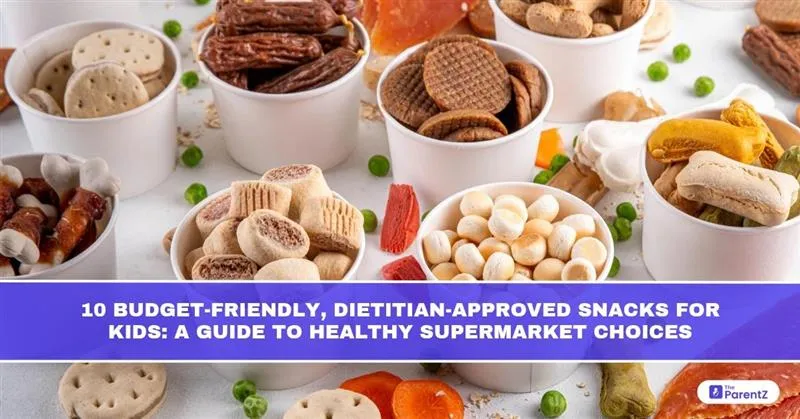Snacks play a vital role in children’s daily nutrition, often bridging the gap between main meals and supporting growth, brain function, and energy levels. However, with increasing concerns about childhood obesity, picky eating habits, and rising grocery costs, parents need simple, affordable, and nutritionally balanced options.
What Makes a Snack “Healthy” for Kids?
According to the NHS Eatwell Guide, a healthy snack for children should be:
- Low in added sugars and sodium
- High in fibre, complex carbohydrates, and protein
- Free from ultra-processed ingredients and trans fats
- Rich in micronutrients like calcium, iron, vitamin D, and B vitamins
- Age-appropriate in texture, portion size, and allergen safety
A 2023 review in Paediatrics and Child Health journal emphasized the importance of “nutrient-dense mini meals” that help prevent micronutrient deficiencies, boost immunity, and support behavioural and cognitive development in children aged 4 to 12.
10 Dietitian-Approved, Budget-Friendly Snacks for Kids
These snacks are suitable for lunchboxes, post-playtime hunger, school breaks, and even travel. While originally inspired by Aldi’s value-for-money items, these are widely available in local supermarkets, general stores, and online in most regions.
1. Wholegrain Crackers with Nut or Seed Butter
A source of complex carbs, fibre, and healthy fats.
Why it’s recommended:
- Wholegrains help in satiety and digestion
- Nut butters (like peanut or almond) provide protein and essential fatty acids
- Easy to pack and does not require refrigeration
Note: For nut allergies, sunflower seed butter or roasted chickpea spread can be used.
2. Plain Greek Yoghurt with Fresh Fruit
Provides calcium, probiotics, and natural sweetness.
Why it’s recommended:
- Greek yoghurt is high in protein and supports bone development
- Fresh fruits like banana, mango, or berries add vitamin C and fibre
- Helps regulate digestion and supports gut microbiota
Choose unsweetened yoghurt and avoid artificially flavoured variants.
3. Roasted Chickpeas or Makhana (Fox Nuts)
Crunchy, plant-based protein options that kids love.
Why it’s recommended:
- High in fibre and iron
- Low glycaemic index
- No added preservatives when made at home or bought plain
Roasted makhana with light salt or turmeric is especially popular in Indian households.
4. Cheese Cubes with Cucumber or Carrot Sticks
A calcium-rich combo that supports teeth and bone health.
Why it’s recommended:
- Cheese offers protein and calcium for growing bones
- Raw vegetables add fibre and water content for hydration
- A great school or after-play snack
Use mild-flavoured cheeses like paneer, mozzarella, or Amul cubes for picky eaters.
5. Boiled Eggs with Wholegrain Toast Fingers
A wholesome mix of protein, iron, and complex carbs.
Why it’s recommended:
- Eggs are a complete protein source
- Yolk contains choline, vital for brain development
- Ideal for breakfast or as a filling snack
Avoid adding too much salt or processed ketchup. Use mashed avocado or hummus as a dip.
6. Oats and Dry Fruit Laddoos or Bars
A traditional-meets-modern snack with wholesome ingredients.
Why it’s recommended:
- Oats offer beta-glucans that regulate cholesterol and immunity
- Dry fruits like dates, raisins, or apricots add iron and natural sweetness
- No added sugar needed if dates or jaggery are used
Pack into small balls or squares and store in an airtight container.
7. Homemade Vegetable Poha or Upma Cups
A soft, savoury snack rich in iron, folate, and fibre.
Why it’s recommended:
- Easy to digest and highly customisable
- Suitable for toddlers to older kids
- Can be made in advance and reheated
Add peas, grated carrots, or spinach for extra micronutrient content.
8. Fresh Fruit Kebabs or Fruit-Chaat Mix
Naturally sweet, colourful, and rich in antioxidants.
Why it’s recommended:
- Visually appealing and bite-sized
- Great for building healthy fruit-eating habits
- Citrus fruits add vitamin C and hydration
Avoid adding synthetic chat masala or salt. Use a squeeze of lemon for taste.
9. Vegetable-Stuffed Whole Wheat Paratha Rolls
A complete mini-meal wrapped into a convenient format.
Why it’s recommended:
- Whole wheat flour adds fibre and B vitamins
- Filling of paneer, spinach, mashed peas, or potato offers nutrients
- Portable and easy to eat
Can be dipped in curd or tomato chutney. Avoid frying in excess oil.
10. Frozen Banana Bites or Homemade Fruit Lollies
A cooling, dessert-like snack with no added sugar.
Why it’s recommended:
- Natural fruit sugars make it child-friendly
- Can be made with banana, mango puree, or watermelon juice
- A healthy alternative to ice creams
For banana bites, dip banana pieces in yoghurt and freeze. For lollies, use a mix of fruit pulp and coconut water.
What to Watch Out For in “Kid-Friendly” Packaged Snacks
Despite labels like “natural” or “made for kids,” many packaged snacks are high in hidden sugars, trans fats, and sodium. Dietitians and the NHS recommend reading nutrition labels carefully:
- Limit snacks with more than 5g of added sugar per serving
- Avoid those with hydrogenated oils or artificial colours
- Choose products with whole ingredients listed at the top
- Watch out for deceptive claims like “fruit flavoured” vs. “real fruit”
A 2022 BMJ review found that over 60% of snacks marketed to children in the UK were classified as “ultra-processed,” with low nutritional value.
When and How Often Should Kids Snack?
As per NHS guidelines and paediatric nutrition experts, most children benefit from two to three snacks a day, depending on age, activity level, and main meal timings.
Ideal snack timing:
- Mid-morning (10–11 am)
- Afternoon (3–4 pm)
- Optional light evening snack (6–6:30 pm for early sleepers)
Avoid snacking too close to mealtimes to maintain appetite for balanced meals.
Conclusion
Healthy snacking doesn’t have to be expensive or complicated. With thoughtful planning and basic nutrition awareness, parents can offer children a variety of snack options that support growth, immunity, learning, and long-term health. Most of the snacks listed above are affordable, readily available, and can be prepared with minimal effort.
The key lies in offering a balance of nutrients, choosing whole and minimally processed ingredients, and building healthy habits early on. Whether you’re shopping at a supermarket or a local kirana store, these options are versatile enough to keep both your child’s taste buds and their health in check.
References
- NHS Eatwell Guide. National Health Service, UK.
- Paediatrics and Child Health Journal, 2023; Vol. 28(2).
- Public Health England, Sugar Reduction Guidelines.
- BMJ Open, 2022 – “Nutritional Quality of Children’s Packaged Snacks in Supermarkets.”
- PubMed Database – “Dietary patterns and growth in early childhood.”








Be the first one to comment on this story.